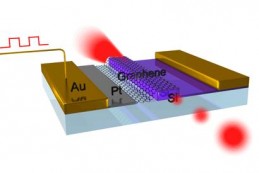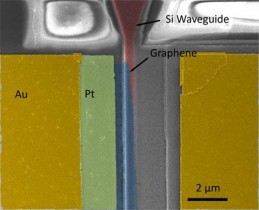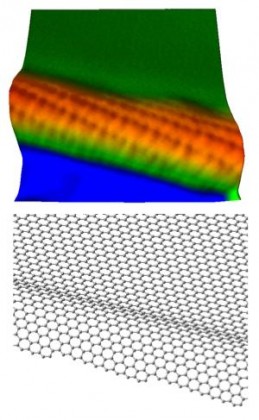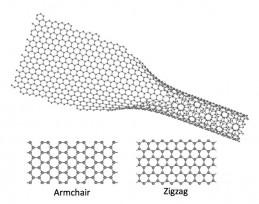Graphene research promises nanoelectronics breakthroughs
May 9, 2011
Graphene is rapidly shifting from a lab curiosity to early versions of future nanoscale electronic devices.
The first precise measurements of the “edge states” of well-ordered nanoribbons have been made by physicists at the Lawrence Berkeley National Laboratory (Berkeley Lab) and colleagues at the University of California, Berkeley and Stanford University. The research promises to allow for building quick-acting, energy-efficient nanoscale devices from graphene-nanoribbon switches, spin-valves, and detectors, based on either electron charge or electron spin.
Graphene rolled into a cylinder makes a nanotube, but with jagged edges. The researchers solved the problem of detecting nanoribbon edge states with a novel method of chemically “unzipping” carbon nanotubes.
When nanotubes are unzipped in this way, the slice runs straight down the length of the tube, leaving well-ordered, straight edges.
Using an scanning tunneling microscope (STM) in spectroscopy mode, the team measured electronic density changes as the STM tip was moved from a nanoribbon edge inward toward its interior.
The researchers discovered that electrons are confined to the edge of the nanoribbons, and that these nanoribbon-edge electrons exhibit a pronounced splitting in their energy levels.
For nanoribbons with an armchair edge, their diffraction pattern spans the full width of the nanoribbon; the resulting electron states are quantized in energy and extend spatially throughout the entire nanoribbon.
For nanoribbons with a zigzag edge, however, the situation is different. Here diffraction from edge atoms leads to destructive interference, causing the electron states to localize near the nanoribbon edges. Their amplitude is greatly reduced in the interior.
Graphene optical device for ultra-high-speed data transmission

A layer of graphene (black fishnet) is placed on top of a silicon waveguide (blue), which is used as an optical fiber to guide light. Electric signals sent in from the side of the graphene through gold (Au) and platinum (Pt) electrodes alter the amount of photons the graphene absorbs (credit: Ming Liu)
In a related development, a tiny optical device that uses graphene as a switch has been developed by scientists at the University of California, Berkeley.
This switching ability is the fundamental characteristic of a network modulator, which controls the speed at which data packets are transmitted. The faster the data pulses are sent out, the greater the volume of information that can be sent.
The researchers layered graphene on top of a silicon waveguide to fabricate optical modulators. The researchers were able to achieve a modulation speed of 1 gigahertz, but they noted that the speed could theoretically reach as high as 500 gigahertz for a single modulator.
This could allow consumers to stream full-length, high-definition, 3-D movies in a matter of seconds, the researchers said.
Graphene-based modulators could also overcome the space barrier of optical devices (the footprint of a typical commercial modulator can be as large as a few square millimeters).

Scanning electron microscope (SEM) image shows gold (Au) and platinum (Pt) electrodes used to apply electrical charges to the sheet of graphene, shown in blue, placed on top of the silicon (Si) waveguide, shown in red (credit: Ming Liu)
The researchers successfully shrunk a graphene-based optical modulator down to a relatively tiny 25 square microns, a size roughly 400 times smaller than a human hair.
Even at such a small size, graphene has tremendous bandwidth capability. Graphene can absorb a broad spectrum of light, ranging over thousands of nanometers, from ultraviolet up to infrared wavelengths.
This allows graphene to carry more data than current state-of-the-art modulators, which operate at a bandwidth of up to 10 nanometers, the researchers said.
Ref: Chenggang Tao, Liying Jiao, Oleg V. Yazyev, Yen-Chia Chen, Juanjuan Feng, Xiaowei Zhang, Rodrigo B. Capaz, James M. Tour, Alex Zettl, Steven G. Louie, Hongjie Dai, Michael F. Crommie, Spatially resolving edge states of chiral graphene nanoribbons, Nature Physics, 2011; DOI: 10.1038/nphys1991
Ref: Ming Liu, Xiaobo Yin, Erick Ulin-Avila, Baisong Geng, Thomas Zentgraf, Long Ju, Feng Wang & Xiang Zhang, A graphene-based broadband optical modulator, Nature (2011) doi:10.1038/nature10067

